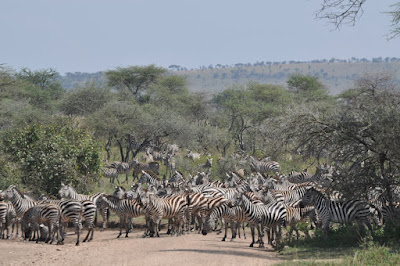 A herd of zebras grazed among the acacias two hundred yards away from where the lion lurked. The herd was gradually working its way to the watering hole just across the road at the edge of the trees.
A herd of zebras grazed among the acacias two hundred yards away from where the lion lurked. The herd was gradually working its way to the watering hole just across the road at the edge of the trees.The lion knew she was in a bad position. She had too much open ground between her and the herd. Zebras have outstanding eyesight and can easily spot a small threatening movement. The zebras are also much faster than a lion, meaning the big cat must get within twenty yards to assure success.
 As the moments passed the lion tried to improve her position one step at a time. She seemed to almost crawl across the earth; her belly was rubbing the dirt. Her dusty brown color provided camouflage, as she remained hidden amidst the grass stalks and small bushes.
As the moments passed the lion tried to improve her position one step at a time. She seemed to almost crawl across the earth; her belly was rubbing the dirt. Her dusty brown color provided camouflage, as she remained hidden amidst the grass stalks and small bushes.The zebras continued to eat the grass and the leaves of the trees. They gathered in small groups of two, three and four for defensive purposes. The zebras often stood next to each other each facing in opposite directions. They were especially weary near the watering hole where predators would frequently strike at thirsty prey.
As the late afternoon heat beat down on this corner of the Serengeti preserve the lion seemed impatient. It took a few more steps with every move.
Suddenly a second lion popped out of the tall bushes to the rear. She edged her way down the back of the field and then turned toward the herd settling in a position twenty yards closer to the watering hole than the first lion. The two lions were poised to attack in tandem.
So far the zebras had detected nothing. Their leader stepped onto the road and scouted the pond. Others slowly followed suit. Soon a half dozen stripped creatures were sipping water, looking up after each drink. More and more of the herd found their way to the water. Their tails were swatting at tse tse flies and other insects. It appeared to be an orderly chaos as the zebras bumped into each other coming and going from the water.
The lions continued to survey the scene from the grassland about one hundred yards away. They each were selecting a target of opportunity.
 In a flash the zebras exploded into action, racing in all directions away from the water. The lions had been detected. Within a split second the lions leaped from their positions and raced toward the herd. Dust kicked up by the hooves of the zebras obscured the scene. The lions barreled full speed into the cloud as the zebras screamed and sprinted with more urgency.
In a flash the zebras exploded into action, racing in all directions away from the water. The lions had been detected. Within a split second the lions leaped from their positions and raced toward the herd. Dust kicked up by the hooves of the zebras obscured the scene. The lions barreled full speed into the cloud as the zebras screamed and sprinted with more urgency.When the dust settled it was clear that the lions had failed in their attack. Lions generally only succeed about half of the time.
The zebras had regrouped to safer ground further into the trees. Shaken by the attack they cackled, brayed and barked loudly in a furious frenzy.
 The two lions, resigned to defeat, joined each other under a tree. They comforted one another with a nudge of the nose and a lick. They then laid down to rest. They were hungry but dinner would have to wait. Soon they would rejoin their pride and begin the hunt anew.
The two lions, resigned to defeat, joined each other under a tree. They comforted one another with a nudge of the nose and a lick. They then laid down to rest. They were hungry but dinner would have to wait. Soon they would rejoin their pride and begin the hunt anew.There are nearly a million zebras in the Serengeti. Their population remains fairly constant because of the many predators they face every day, including hyenas, leopards, cheetahs and lions. Such is life in the Serengeti.
No comments:
Post a Comment